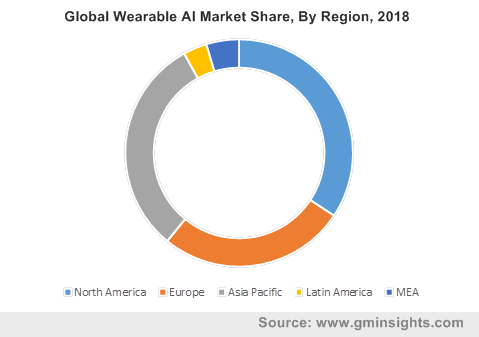3 pivotal trends impacting wearable artificial intelligence (AI) market growth
Publisher : Fractovia | Published Date : 2019-06-07Request Sample
In recent years there has been a veritable explosion in wearable artificial intelligence (AI) market, primarily on account of the robust proliferation of advanced technologies. While wearables have been popular since quite a while now, the incorporation of AI has endowed them with more capabilities than ever before. A gist of some of the major factors that are responsible for fueling wearable AI market growth in the year 2019 has been enlisted underneath.
U.S. Wearable AI Market Share, By Product, 2018

Smartwatches becoming more popular: Smartwatches are increasingly coming to eclipse smartphones thanks to the rising trends of AI and 5G. The smartphone has become a central hub for recording or displaying data collected from various wearable devices that a user might be wearing all over the body. It has been estimated that over 2 billion people had smartphones in 2016, and the figure is predicted to increase to 2.5 billion by 2019.
Exponential growth has been recorded for both mobile and ai wearable devices over the past decade, in spite of the second dot-com bubble that disrupted social media share values and the Global Financial Crisis. In fact, intelligent wearables are encouraging people to workout and by providing continuous data, are helping to raise health awareness. The smartphone fad, undoubtedly, has helped foster wearable artificial intelligence (AI) industry growth.
Increasing disposable income: As numerous new entrants are rapidly entering wearable AI market, established tech companies like Apple, Samsung, Microsoft, Google and others are also expanding into the exceptionally profitable wearable AI industry space. Thus wearable AI market growth has come to be characterized by intense competition, which is making wearable technologies much more affordable. Apart from this though, sales of intelligent wearables have also been peaking lately on account of the rising disposable incomes of consumers worldwide.
While the economy is rapidly stabilizing and even thriving in developed nations, the rising middle class in emerging economies has been pegged as aggressive consumers, spending a considerable portion of their incomes on latest technologies and in turn dictating wearable technology future trends. The impact of the same is no doubt, rather visible in the latest wearable AI industry forecasts.
Health monitoring awareness: Possibly the one space where wearable technology has been most effective and pervasive is healthcare. Recently, the FDA approved the first wearable AI meant for medical monitoring at home. The wearable device developed by Current Health measures multiple vital signs such as patient’s pulse, mobility, oxygen saturation, respiration and temperature and sends real-time updates to physicians enabling them to tackle complications promptly.
The technology utilizes machine learning to analyze the collected data to detect problematic changes in the patient’s body. Apart from detecting critical health parameters, devices are also being developed to notify users of the more controllable and adjustable changes in their bodies such as whether they are gaining weight or if they need to change their nutritional intake.
It has been observed that most wearable AI market forecasts indicate a significant growth for the industry due to the explosion of these devices in healthcare. Supporting the statement is that fact that the proliferation of ai wearable devices in healthcare industry has come to catch the attention of global tech conglomerates.
For instance, the Apple Watch Series 4 was the first smartwatch to introduce a personal electrocardiogram that would measure the heart’s electrical activity and alert the wearer if it detects causes of concern. The HeartGuide by Omron is a smartwatch that can measure blood pressure. Such devices are being highly preferred as they are an investment in health and can effectively save huge healthcare expenses later on. Another upside that has prompted more wearable AI market players into producing wearable health devices is the immense data that can reportedly be sourced from these devices which will be crucial for healthcare industry.
Not only the healthcare industry, but the sports industry is also racing to upgrade its offerings in the form of smart wearables. For instance, wearable technology is being developed that can warn footballers about the possibility of a concussion in case they are hit too hard or help golfers fine tune their swing. Smart Caddie developed by Game Your Game is an AI that acts as a personal caddie and helps golfers make data driven decisions with every shot they hit as it not only understands the player’s tendencies but also adjusts for weather and elevation while understanding the course and making suggestions.
As consumers are increasingly adopting smart devices to be worn on the body, wearable AI market growth is bound to witness an added impetus over the coming years. Indeed, prominent wearable AI industry forecasts claim the market to register a double-digit CAGR over 2019-2025. As the competition stiffens, wearable AI industry players are diversifying their approach in the development of devices which has led to the increasing penetration of wearable AI devices in security, gaming and even fashion. Characterized by extensive growth prospects, wearable AI market share is expected to surpass $180 billion by 2025.